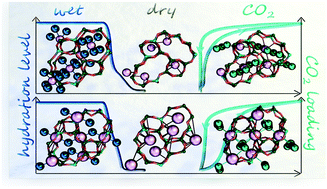Framework flexibility-driven CO2 adsorption on a zeolite†
Abstract
Adsorption of the greenhouse gas CO2 by ordered porous materials, although cost-efficient and eco-friendly, has not yet achieved large-scale practical application. Here, we report that zeolite framework flexibility can be exploited by tuning a subtle interplay between extra framework cations with framework oxygen and adsorbed guest molecule (CO2). This phenomenon has been demonstrated on the Na+, K+ and Rb+ forms of the small-pore zeolite gismondine with a Si/Al ratio of 3.0, which show marked cation-dependent hystereses in their CO2 isotherms. A detailed analysis of the structures by solid state NMR and XRD revealed that the framework dynamics and the adsorption behavior is governed by the extra framework cations, which strive for coordination either with framework oxygen, guest molecules, or both. The K+ and Rb+ forms display very high CO2 working capacities (2.8 and 3.0 mmol g−1) for a 50 : 50 CO2/CH4 mixture under mild temperature swing conditions (25–100 °C at 1.0 bar), as well as high CO2/CH4 selectivities (36 and 28) at 25 °C. Given the excellent thermal and chemical stability of zeolites compared to other classes of adsorbents, and the here reported tuneable flexing action effected by the cations, zeolites displaying framework flexibility harbour great potential for fuel gas applications.



 Please wait while we load your content...
Please wait while we load your content...